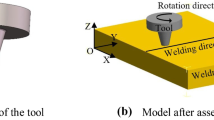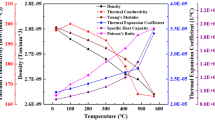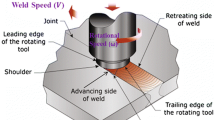Abstract
Optimal selection of friction stir welding (FSW) process parameters is critical for ensuring an even temperature distribution and high weld quality. This study ascertained the impact of process parameters on temperature distribution in the core area of friction stir welded 2219 aluminum alloy thick plate and determined the optimal combination (the range of rotational speed was estimated as 457.15–500.00 r/min, the welding speed was found within the range of 68.50–84.75 mm/min) of these parameters. The FSW process simulation model of 2219 aluminum alloy thick plate was established using DEFORM. The temperature field simulations of plunging, dwelling, welding, and withdrawal phases of FSW were also realized. Thermocouple temperature measurement experiments were performed to validate the model. The impact of welding process parameters on the core area’s maximum temperature and temperature difference was also investigated. The polynomial fitting method was used to establish a prediction model based on maximum and minimum temperatures of the FSW core area. The surface-fitting method was applied to draw the fitting surfaces of maximum and minimum temperatures, which intersected with the upper and inferior limit planes of reasonable welding temperature of 2219 aluminum alloy material, respectively. The intersection line was projected onto the plane with welding and rotational speeds as horizontal and vertical coordinates, respectively, and the optimized combination of welding process parameters was obtained.























Similar content being viewed by others
Data availability
All data generated or analyzed during this study are included in this manuscript.
Code availability
The code is available on request.
References
Barmin IV, Neustroev VN, Lebedeva LI (2018) Problems of ground safety supporting at launch of space vehicle with manned spacecraft. Acta Astronaut 150:6–14. https://doi.org/10.1016/j.actaastro.2017.12.008
Wang GQ, Zhao YH, Hao YF (2018) Friction stir welding of high-strength aerospace aluminum alloy and application in rocket tank manufacturing. J Mater Sci Technol 34:73–91. https://doi.org/10.1016/j.jmst.2017.11.041
Chen GQ, Shi QY (2015) Recent advances in numerical simulation of material flow behavior during frictions stir welding. J Mech Eng 51:11–21. https://doi.org/10.3901/JME.2015.22.011
Thomas WM, Nicholas ED, Watts ER, Staines DG (2002) Friction based welding technology for aluminium. Mater Sci Forum 54(2):49–93. https://doi.org/10.1179/174328009X411136
Shao MH, Wang CM, Zhang H, Zhang J, Liu DB, Wang FF, Ji YJ, Chen GQ (2022) Microstructure and corrosion behavior of bobbin tool friction stir welded 2219 aluminum alloy. Mater Charac 192:112178. https://doi.org/10.1016/j.matchar.2022.112178
Lu XH, Zhou Y, Sun SD, Luan YH, Qiao JH, Qian J (2022) Temperature field measurement and analyses of friction stir welding of 18mm thick 2219 aluminum alloy. Exp Tech 47(3):579–590. https://doi.org/10.1007/s40799-022-00556-7
Dialami N, Cervera M, Chiumenti M (2019) Defect formation and material flow in friction stir welding. Metals 80:103912. https://doi.org/10.1016/j.euromechsol.2019.103912
Biswas P, Kumar DA, Mandal NR (2012) Friction stir welding of aluminum alloy with varying tool geometry and process parameters. Proc Inst Mech Eng Part B: J Eng Manuf 226(4):641–648. https://doi.org/10.1177/0954405411424111
Mao YQ, Ke LM, Liu FC, Chen YH, Li X (2016) Investigations on temperature distribution, microstructure evolution, and property variations along thickness in friction stir welded joints for thick AA7075-T6 plates. Int J Adv Manuf Tech 86(1–4):141–154. https://doi.org/10.1007/s00170-015-8182-z
Ramachandran KK, Murugan N, Shashi KS (2016) Performance analysis of dissimilar friction stir welded aluminium alloy AA5052 and HSLA steel butt joints using response surface method. Int J Adv Manuf Technol 86(9):1–20. https://doi.org/10.1007/s00170-016-8337-6
Zhu R, Gong WB, Cui H (2020) Temperature evolution, microstructure, and properties of friction stir welded ultra-thick 6082 aluminum alloy joints. Int J Adv Manuf Technol 108(1):331–343. https://doi.org/10.1007/s00170-020-05422-7
Gao H, Dong JH, Zhang K, Luan GH (2014) Variations of the microstructure and mechanical properties for the thick aluminum friction stir welding joint along the thickness direction. Trans China Weld Inst 35(8):61–65 (in Chinese)
Iordache M, Bădulescu C, Niţu E, Iacomi D (2016) Numerical simulation of friction stir welding (FSW) process based on ABAQUS environment. Solid State Phenomena, Trans Tech Publications, Ltd 254:272–277. https://doi.org/10.4028/www.scientific.net/SSP.254.272
Ma ZS, Hou XY, Chen SR (2018) Effects of sizes of stirring head shoulder on performance of 2219 aluminum alloy friction stir welding joint. Hot Work Technol 47(05):194–202. https://doi.org/10.14158/j.cnki.1001-3814.2018.05.050. (in Chinese)
Asadi P, Mahdavinejad RA, Tutunchilar S (2011) Simulation and experimental investigation of FSP of AZ91 magnesium alloy. Mater Sci Eng A 528(21):6469–6477. https://doi.org/10.1016/j.msea.2011.05.035
Šibalić N, Vukčević M, Janjić M, Savićević S (2016) A study on friction stir welding of AlSi1MgMn aluminium alloy plates. Teh Vjesn 23(3):653–660. https://doi.org/10.17559/TV-20131215184202
Buffa G, Hua J, Shivpuri R, Fratini L (2006) A continuum based FEM model for friction stir welding-model development. Mater Sci Eng A 419(1–2):389–396. https://doi.org/10.1016/j.msea.2005.09.040
Jain R, Pal SK, Singh SB (2016) A study on the variation of forces and temperature in a friction stir welding process: a finite element approach. J Manuf Processes 23:278–286. https://doi.org/10.1016/j.jmapro.2016.04.008
Zhang ZQ, Jiang ZL, Wei QY (2017) Dynamic mechanical properties and constitutive equations of 2219 aluminum alloy. J Mater Eng 45:47–51. https://doi.org/10.1016/s1003-6326(14)63330-6
Jain R, Pal SK, Singh SB (2019) Investigation on effect of pin shapes on temperature, material flow and forces during friction stir welding: a simulation study. Proc Inst Mech Eng Part B: J Eng Manuf 233(9):1980–1992. https://doi.org/10.1177/0954405418805615
Xu WF, Liu JH, Zhu HQ (2010) Numerical simulation of thermal field of friction stir welded 2219 aluminum alloy thick plate. Trans China Weld Inst 31:63–66 (in Chinese)
Ambrosio D, Wagner V, Garnier C, Jacquin D, Dessein G (2020) Influence of welding parameters on the microstructure, thermal fields and defect formation in aa7075-t6 friction stir welds. Weld World 64(5):773–784. https://doi.org/10.1007/s40194-020-00869-4
Xiao S, Deng YF, Zeng JC, Zhang W, Huang LR (2021) Effect of heat input on microstructure and mechanical properties of friction stir welded AA2024 and AA7075 dissimilar alloy. J of Mater Eng Perform 31(11):7989–7997. https://doi.org/10.1007/s11665-021-06000-y
Zhai M, Wu CS (2021) Tool/workpiece interface temperature measurement and prediction. J Mech Eng 57(4):36–43. https://doi.org/10.3901/JME.2021.04.036. (in Chinese)
Hwang YM, Fan PL, Lin CH (2010) Experimental study on friction stir welding of copper metals. J Mater Process Technol 210(12):1667–1672. https://doi.org/10.1016/j.jmatprotec.2010.05.019
Funding
This research was supported by the National Key Research and Development Program of China (Grant No. 2019YFA0709003) and Natural Science Foundation of Liaoning Province of China(2023-MS-101). The financial contributions are gratefully acknowledged.
Author information
Authors and Affiliations
Contributions
XL: conceptualization, supervision, methodology, funding acquisition, project administration. YL: software, investigation, formal analysis, data curation, validation, writing—review and editing. JQ: conceptualization, methodology, investigation, software, validation, writing—original draft. BY: formal analysis and investigation. WZ: formal analysis, data curation. SYL: resources.
Corresponding author
Ethics declarations
Ethics approval
Not applicable.
Consent to participate
Not applicable.
Consent for publication
The authors consent the work entitled as “Optimization of process parameters in friction stir welding of 2219 aluminum alloy thick plate” for possible publication in the International Journal of Advanced Manufacturing Technology.
Competing interests
The authors declare no competing interests.
Additional information
Publisher's Note
Springer Nature remains neutral with regard to jurisdictional claims in published maps and institutional affiliations.
Rights and permissions
Springer Nature or its licensor (e.g. a society or other partner) holds exclusive rights to this article under a publishing agreement with the author(s) or other rightsholder(s); author self-archiving of the accepted manuscript version of this article is solely governed by the terms of such publishing agreement and applicable law.
About this article
Cite this article
Lu, X., Luan, Y., Qiao, J. et al. Optimization of process parameters in friction stir welding of 2219 aluminum alloy thick plate. Int J Adv Manuf Technol 129, 4201–4215 (2023). https://doi.org/10.1007/s00170-023-12577-6
Received:
Accepted:
Published:
Issue Date:
DOI: https://doi.org/10.1007/s00170-023-12577-6




